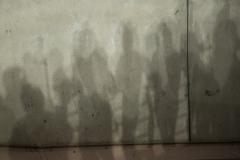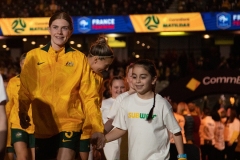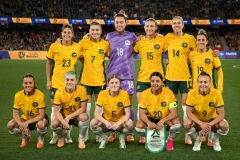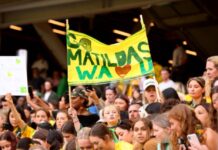![IMG_2470[36345]](https://beyond90.com.au/wp-content/uploads/2020/07/IMG_247036345.jpg)
![IMG_2470[36345]](https://beyond90.com.au/wp-content/uploads/2020/07/IMG_247036345.jpg)
It was a different time.
That is the most common sentiment in all the reflections on the Matildas’ journey to and debut at the 1995 World Cup in Sweden.
This is a look back on the Matildas’ first official Women’s World Cup appearance, twenty-five years on.
Setting the scene
After Australia took part in the first FIFA-sanctioned women’s invitational event in 1988, it would be seven years before the team returned to that level.
Australia failed to qualify for the inaugural Women’s World Cup in 1991 and didn’t play any international matches in 1990, 1992, or 1993. However, four days in September 1993 were about to give the women’s game, particularly in Australia, a boost.
“About six months or so before the [1995] qualifiers, women’s football became an Olympic sport. And then almost simultaneously, Sydney got announced for 2000”, Tom Sermanni, the longest serving Matildas coach explained.
For the Australian Women’s Soccer Association (AWSA) – a completely separate body from the Australian Soccer Federation – this was huge. It suddenly had funding like never before and a guaranteed spot at an Olympic tournament on home soil. The money allowed national programs to begin and the association to hire people, including Sermanni, to run them.
“I came in at a very lucky time because I came in when the funding came in or because the funding came in – they were able to have a full time coach.
“So prior to that time it was a tough gig, women’s soccer. There was no money in the sport, players basically funded themselves to play for the national teams. It was very, very different times.”
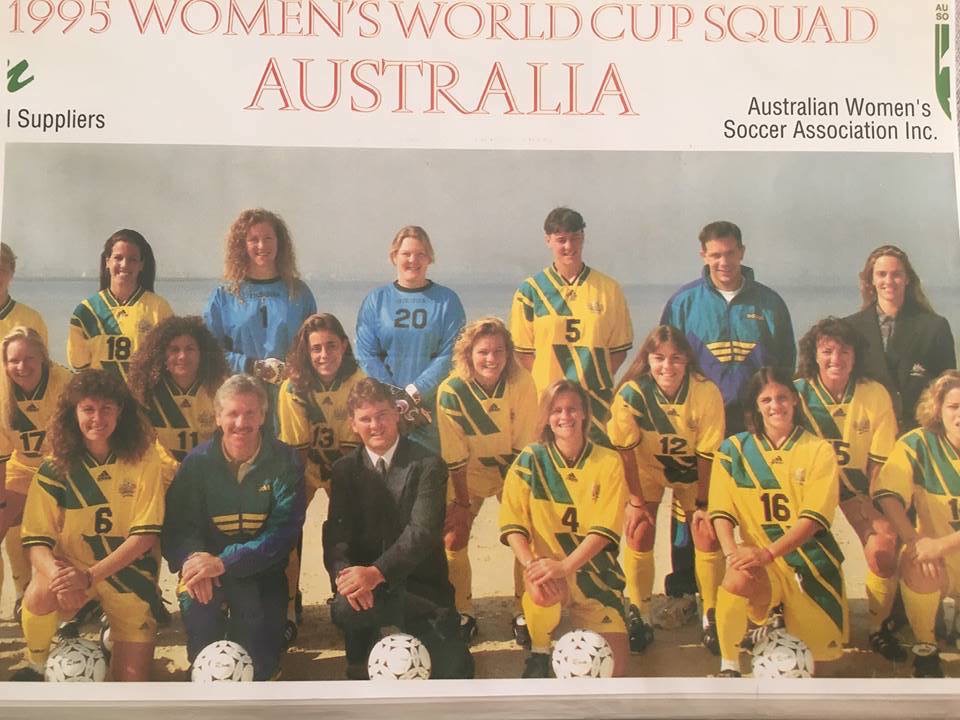
Qualification
The 1994 Oceania Women’s Championship served as the World Cup qualifiers. It once again came down to Australia and New Zealand, as it did for the 1991 World Cup.
The tournament held in Papua New Guinea may be the only time the Australian national team has worn red.
“Our playing shirts were coming up from Melbourne to Papua New Guinea and went missing. So we actually turned up to get ready for the first game without any Australian shirts”, Sermanni reminisced.
“I had been coaching at the AIS in the men’s program. And Ron Smith sent up the boys’ red AIS playing shirts. So our first game against New Zealand at the World Cup qualifiers we actually played in red AIS shirts, and that’s one of the early memories of the tournament.”
Alison Leigh Forman debuted for the national team in 1989 and would go on to play every minute of the 1995 World Cup. For her, there was a thrill in being able to travel to play football.
“Heading to Papua New Guinea to play the tournament was super exciting in itself, it is not every day that you get to travel to such a fascinating destination.
“The tournament itself went ok, we finished equal with New Zealand, but we had a better goal difference. I remember being extremely happy and to be heading to a FIFA World Cup. The FIFA World Cup is the pinnacle for a footballer who dreams of playing on the world stage, it was a dream come true.”
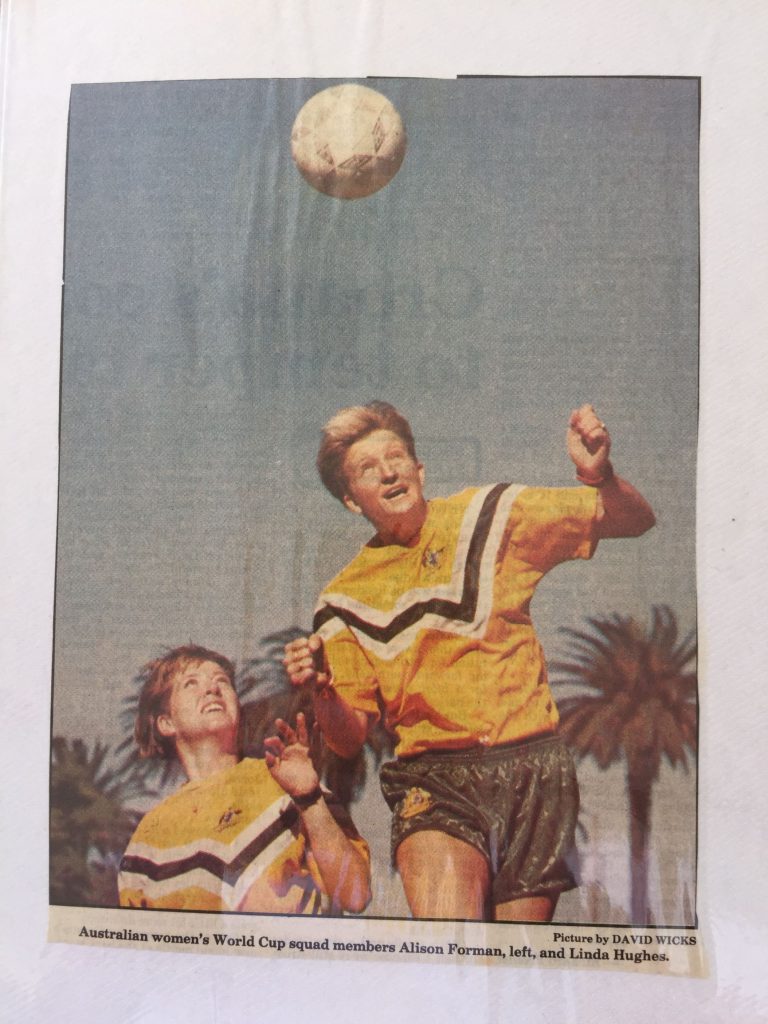

There wasn’t a lot of fanfare when the team returned home. The anonymity of women’s football, and the stature of the code as a whole, meant it barely registered in the media.
The World Cup wasn’t just an incredible opportunity in the short term. It was also invaluable in improving the women’s national team set up as a whole.
“The key thing for us at that stage was qualifying continued the momentum. If we hadn’t qualified, it would have really impacted the momentum and potentially impacted the programs that we were trying to put in place”, Sermanni said.
Signs of the times
The AWSA was wholly and solely in charge of running the women’s game and the national team. It was in no way formally affiliated to the Australian Soccer Federation. However, the former needed the latter’s approval to participate in international competitions.
“There was no great inclination at that time to unite the organisations. And to be honest, I don’t think either organisation wanted it. The women’s body basically got on and ran themselves”, Sermanni said.
“The main thing was that whenever you went to an official tournament, you had to get the approval of the national body. You went there as representatives of the Soccer Federation, as opposed to the AWSA because they weren’t the recognised FIFA body at that stage.”
France 2019 saw the Matildas wear bespoke Nike kits. But in 1995, the team was decked out in hand-me-downs. Julie Murray remembers in Fiona Crawford’s and Lee McGowan’s Never Say Die that the 1995 team wore “shirts that were in the storage shed that the Socceroos didn’t wear.” This meant they were all men’s sizes with some requiring alterations performed by members of staff on tour.
Media coverage was also very different to today.
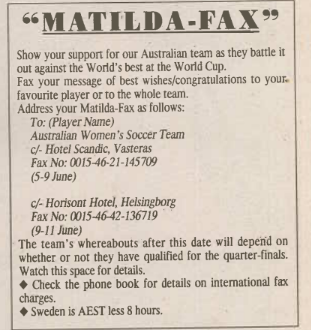

Sarah Groube was the National Teams Administrator at the time. She didn’t fly to Sweden but was still heavily involved, keeping those here in Australia informed.
“Moya Dodd went over as the Team Administrator as she had done her knee, so couldn’t play and was on the bench. I would ring her every 10 minutes during each match to find out what had happened and I would write that into my match report.
“At the end of the game I would have to fax it off to our long list of media contacts. It would take well over an hour for the faxes to all go through – I think I could only program about 10 numbers at a time. If they were engaged you would have to start again!
“This was usually in the middle of the night in winter in Canberra, in our little classroom office at the old ACT Sports House so I would be sleeping on the floor waiting for kick off.”
Heading to Sweden
Pre-tournament, an AWSA and SBS-run competition saw the ‘Matildas’ name selected by popular vote.
Let's just say we should be glad the Matilda's name got up. Here was the voting to select the name. pic.twitter.com/TWog8ohuup
— Death to the NSL (@DeathNsl) April 26, 2019
While the public was naming the team, the players themselves were preparing for the tournament.
“Prior to the World Cup – we played USA in Phoenix, New Zealand in Canberra, Argentina and Brazil in Uberlandia, Canada in Vancouver, Scotland in Kilmarnock and Sweden in Helsingborg”, Forman recalled.
“It was fantastic to travel with the team; you get to know your teammates on a different level when you’re on the road and when you’re playing different types of opponents, it is always a benefit.”
Australia drew Denmark, China, and the reigning champions, the USA – all powerhouses of the game ranked in the top five.
“It was a fairly challenging tournament, and it was very much, to throw in a cliché, a learning curve as to what you might do next”, Sermanni admitted.
The opening game against Denmark couldn’t have gone any worse for Australia. Sonia Gegenhuber was sent off in the first half and the team ultimately conceded five. Forman, one of three Aussies playing abroad at the time, was particularly familiar with Australia’s opponents.
“I knew all the players on the Danish team as I played for Fortuna Hjørring in Denmark at that time. The 5-0 defeat was a devastating start to the tournament.”
Forman’s affinity with Denmark began in 1992 when she first signed for Fortuna and continues to this day. She lives in Denmark and is still involved in football through the Dana Cup, an enormous international youth tournament.
Australia’s next two matches saw another two losses but improved performances and first World Cup goals. Angela Iannotta and Sunni Hughes etched their names into the history books with their goals against China.
“We ended up losing 4-2 to China, but at one stage with about 10 minutes to go it was 3-2. We were in with a slight chance”, Sermanni said.
Lisa Casagrande then scored against the USA. Her goal put Australia into the lead with around 20 minutes to play. The US went on to score four goals, including two in injury time.
“I mainly remember Casa’s goal because when she scored, she tried to turn the shirt around so that ‘Casagrande’ was showing on the front. But she got herself in a muddle so that stands out in my head probably a little bit more than the goal”, Sermanni remembered fondly.
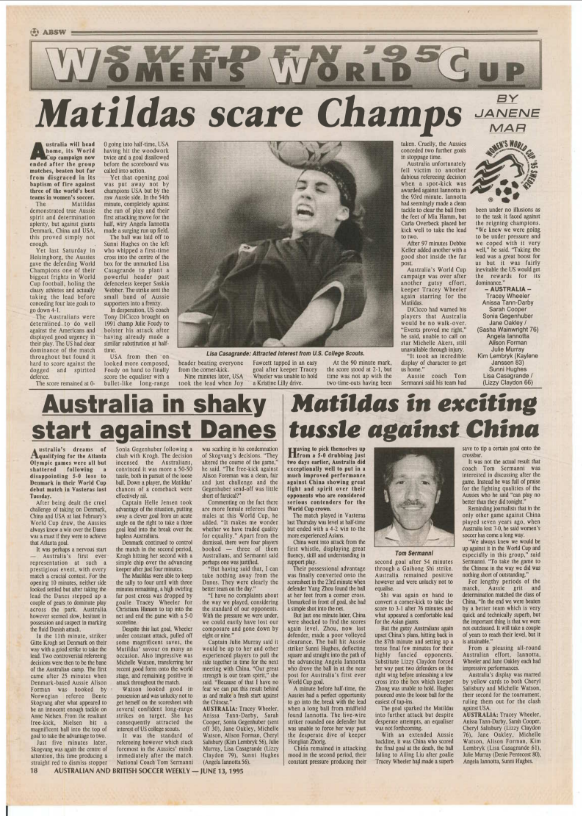

Despite the disappointing results, there were positives.
“It was a good experience to play against the likes of Sun Wen and Mia Hamm and all of the other top-class players at that time. The only way to measure your own ability is to play against the best in the world. We learned that we needed to work harder and make improvements”, Forman said.
For Sermanni, the tournament was a reflection of where Australia was compared with the stronger nations they faced.
The 1995 tournament was by no means the Matildas’ most successful campaign. But it is an important part of the team’s history and in the continuing story of women’s football in Australia, which Forman summed up best.
“We experienced what we did in our time and in our moment and I seriously would not change that for a day. I believe the timing is perfect for Australian football here and now to host the FIFA World Cup in 2023, the stage is set and the hard work actually starts now.”



